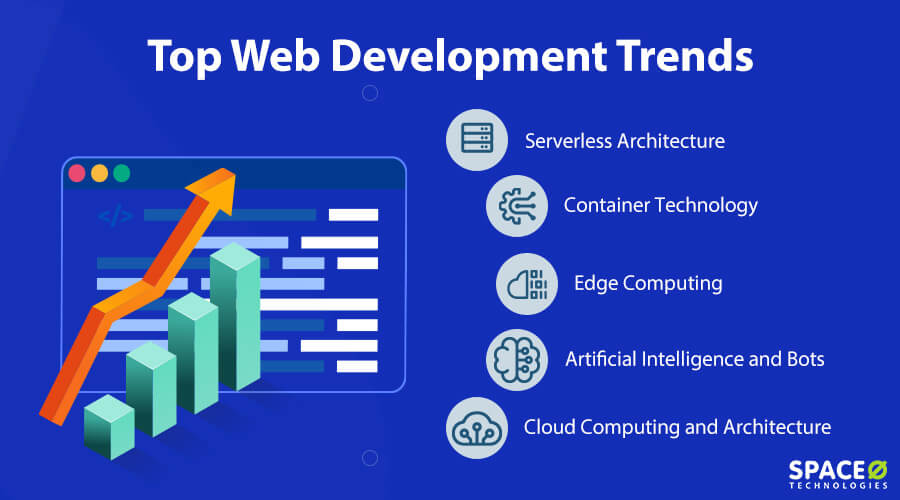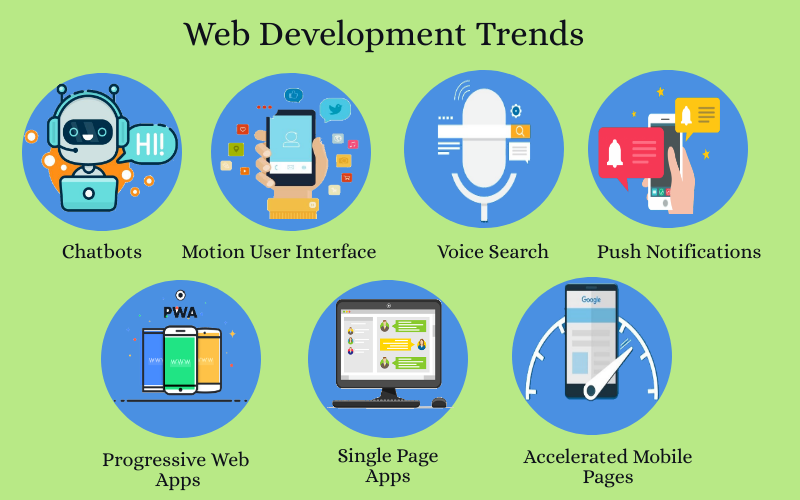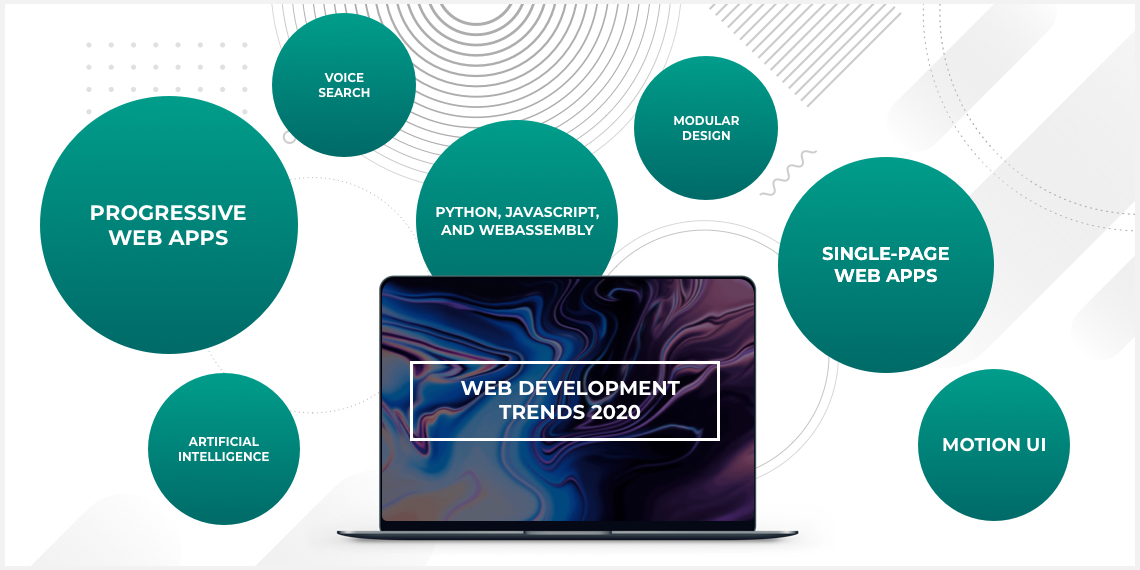
The latest trends in web development include Progressive Web Apps (PWAs), AI integration, and the rise of voice search optimization. These innovations are shaping the future of user experiences.
Web development is evolving rapidly, with new trends enhancing functionality and user engagement. Progressive Web Apps (PWAs) offer the benefits of both web and mobile apps, ensuring seamless performance across devices. Artificial Intelligence (AI) is becoming integral, providing personalized experiences and advanced data analytics.
Voice search optimization is gaining traction as more users rely on voice assistants like Alexa and Siri. Implementing these trends can improve site performance, accessibility, and user satisfaction. Staying updated with these developments is crucial for developers and businesses aiming to maintain a competitive edge in the digital landscape.
Introduction To Modern Web Development
Web development has evolved rapidly over the years. Today, it is more dynamic and user-centric. Modern web development uses cutting-edge technologies to create interactive and responsive websites. This has made the web more accessible and engaging for users worldwide.
Evolution Of Web Technologies
The evolution of web technologies has been remarkable. In the early days, static HTML pages were the norm. These pages were simple and lacked interactivity. Over time, CSS was introduced, allowing for better styling and layouts.
JavaScript then revolutionized the web by enabling dynamic content. Frameworks like Angular, React, and Vue.js have further advanced web development. They allow developers to create complex applications with ease.
| Technology | Year | Impact |
|---|---|---|
| HTML | 1991 | Created the structure of web pages |
| CSS | 1996 | Enhanced styling and layout capabilities |
| JavaScript | 1995 | Enabled dynamic and interactive content |
| Angular | 2010 | Introduced a robust framework for single-page apps |
| React | 2013 | Focused on building user interfaces |
| Vue.js | 2014 | Offered a progressive framework for building UIs |
Importance Of Staying Updated
Staying updated with the latest trends is crucial for web developers. The web development landscape changes quickly. New tools and frameworks emerge regularly.
Updated knowledge helps developers build better and more secure websites. It also ensures that websites are optimized for performance and user experience. Keeping up with trends also opens up new career opportunities.
- Follow industry blogs and websites
- Attend webinars and conferences
- Join developer communities and forums
- Take online courses and certifications
By staying updated, developers can leverage the latest technologies. This enables them to deliver top-notch web solutions.
Progressive Web Apps (pwas)
Progressive Web Apps (PWAs) are a major trend in web development. They combine the best of web and mobile apps. PWAs offer a seamless and fast user experience. They work offline and load quickly. This makes them ideal for users with poor internet connections. PWAs use modern web technologies to provide app-like features.
Benefits Of Pwas
PWAs offer several benefits for both users and developers:
- Offline Capability: PWAs work without an internet connection.
- Fast Loading: They load quickly, improving user experience.
- Push Notifications: PWAs can send push notifications to users.
- Responsive Design: They adapt to different screen sizes.
- Secure: PWAs use HTTPS to ensure security.
- Installation: Users can install PWAs on their home screen.
Successful Pwa Examples
Many companies have successfully implemented PWAs. Here are some notable examples:
| Company | Website | Benefits Observed |
|---|---|---|
| mobile.twitter.com | Increased engagement and reduced bounce rate. | |
| Alibaba | m.alibaba.com | 76% increase in conversions across browsers. |
| Forbes | www.forbes.com | 43% increase in sessions per user. |
Single Page Applications (spas)
Single Page Applications, or SPAs, are modern web applications that load a single HTML page. They dynamically update content as the user interacts with the app. This means no page reloads are necessary, creating a seamless user experience.
Spa Frameworks
Several popular frameworks make building SPAs easier. These frameworks offer tools and libraries to streamline development.
| Framework | Description |
|---|---|
| React | A library by Facebook, known for its component-based architecture. |
| Angular | Developed by Google, it is a complete framework for building SPAs. |
| Vue.js | A progressive framework for building user interfaces. |
Advantages Of Spas
SPAs offer several benefits that make them a popular choice for developers.
- Speed: SPAs load content dynamically, reducing load times.
- Improved User Experience: Users enjoy smooth transitions without page reloads.
- Easy Development: Many frameworks and libraries support SPA development.
- Better Caching: SPAs can cache data effectively, improving performance.
SPAs are a significant trend in web development. They provide a faster and more engaging user experience.
Serverless Architecture
Serverless Architecture is changing the way developers build and deploy applications. By eliminating the need for server management, developers can focus on writing code and improving user experience.
How Serverless Works
In a serverless architecture, developers write code in the form of functions. These functions are then deployed to a cloud provider. The cloud provider manages the infrastructure needed to run these functions. Popular cloud providers include AWS Lambda, Google Cloud Functions, and Azure Functions.
When a function is called, the cloud provider automatically allocates resources to execute it. This means developers no longer worry about server maintenance or scaling issues. The cloud provider handles all of this behind the scenes.
Here’s a simple example in Python:
def hello_world(event, context):
return "Hello, World!"
Pros And Cons
| Pros | Cons |
|---|---|
| Cost-Efficient: Pay only for execution time.Scalability: Automatic scaling based on demand.No Server Management: Focus on writing code. | Cold Start: Initial execution can be slow.Limited Execution Time: Functions have a timeout limit.Vendor Lock-In: Tied to a specific cloud provider. |
While serverless architecture offers many advantages, it’s essential to consider its limitations. Developers must evaluate their specific needs before adopting this approach.
Jamstack Architecture
The JAMstack architecture is transforming web development. JAMstack stands for JavaScript, APIs, and Markup. It promises faster performance, better security, and easier scaling. Developers are moving towards this modern approach for its many benefits.
Components Of Jamstack
JAMstack relies on three main components. Each component plays a crucial role in building modern web applications.
| Component | Description |
|---|---|
| JavaScript | Handles dynamic functionalities. Runs on the client side. |
| APIs | Serves as the backend. Provides data and services. |
| Markup | Pre-built HTML. Delivered by static site generators. |
Use Cases
JAMstack is versatile. It fits various web development needs. Here are some common use cases:
- Static Websites: Faster load times and better SEO.
- eCommerce Sites: Secure and scalable. Handles high traffic.
- Blogs: Easy to manage. Excellent performance.
JAMstack’s flexibility makes it ideal for many projects. It supports both small and large-scale applications. Developers appreciate its simplicity and efficiency.
Webassembly (wasm)
WebAssembly (Wasm) is a revolutionary technology in web development. It allows code to run in web browsers at near-native speed. Wasm bridges the gap between the performance of native applications and the flexibility of the web.
Performance Enhancements
WebAssembly offers significant performance enhancements for web applications. Traditional JavaScript can be slow and inefficient. Wasm runs at near-native speed, making it much faster.
Here are some key performance benefits:
- Reduced load times: WebAssembly modules are smaller and load faster.
- Better execution speed: It runs code closer to the machine’s native speed.
- Improved memory usage: More efficient use of memory resources.
Developers can use languages like C, C++, and Rust to write Wasm. This provides more flexibility and power.
Real-world Applications
WebAssembly is not just theoretical. It has practical applications in various industries.
Here are some real-world applications of WebAssembly:
| Industry | Use Case |
|---|---|
| Gaming | High-performance games run directly in browsers. |
| Video Editing | Advanced video editing tools without installing software. |
| Data Analysis | Complex data visualization and processing in the browser. |
| CAD Applications | 3D modeling tools accessible via web browsers. |
WebAssembly is also used in machine learning. It allows running ML models directly in the browser. This opens up new possibilities for web-based AI applications.
WebAssembly is transforming web development. Its performance benefits and real-world applications make it a game-changer.
Artificial Intelligence In Web Development
Artificial Intelligence (AI) is transforming web development. It helps create smarter and more efficient websites. AI’s capabilities offer new possibilities for developers. Let’s explore how AI is changing web development.
Ai-powered Tools
AI-powered tools are making web development faster and easier. These tools can automate repetitive tasks. They help developers focus on creative work.
- Code Generators: AI can write code snippets quickly.
- Bug Fixing: AI tools can find and fix bugs.
- Design Assistance: AI helps in designing user interfaces.
AI tools save time and reduce errors. They improve the overall quality of websites.
Personalization Techniques
AI enables personalized user experiences. Personalization makes websites more engaging. Let’s see how AI achieves this.
- Recommendation Engines: AI suggests content based on user behavior.
- Chatbots: AI-powered chatbots provide instant support.
- Adaptive Content: AI adjusts content to match user preferences.
Personalization increases user satisfaction. It keeps users coming back to the website.
| AI Tool | Function |
|---|---|
| Code Generators | Generate code snippets |
| Bug Fixing Tools | Identify and fix bugs |
| Design Assistants | Help design user interfaces |
| Recommendation Engines | Suggest content |
| Chatbots | Provide instant support |
| Adaptive Content Tools | Adjust content for users |
AI is reshaping web development. It creates smarter and more engaging websites. AI-powered tools and personalization techniques are at the forefront of this transformation.
Voice Search Optimization
Voice search is becoming more popular. Many people use voice assistants like Siri, Google Assistant, and Alexa to find information. Voice search optimization is the key to staying ahead. Let’s explore how to make your website ready for voice search.
Seo For Voice Search
Optimizing for voice search is different from traditional SEO. Here are a few tips:
- Use natural language: People speak differently than they type. Use conversational phrases.
- Focus on long-tail keywords: Voice searches are usually longer.
- Answer questions: Many voice searches are questions. Use FAQ sections to address them.
- Local SEO: People often use voice search to find local information. Include your location in your content.
Implementing Voice Features
Adding voice features to your website can enhance user experience. Here are some steps:
- Voice Commands: Allow users to navigate your site using voice commands.
- Voice Search: Integrate a voice search option on your website.
- Text-to-Speech: Enable text-to-speech for content on your site. This helps users who prefer listening.
Here is a simple example code for adding a voice search feature:
🎤By following these steps, you can make your website voice search friendly. This will help in staying relevant and accessible to all users.
Motion Ui
Motion UI has revolutionized web development. It makes websites more interactive and engaging. Motion UI uses animations to guide users through a website. It enhances user experience by adding dynamic elements.
Creating Dynamic Interfaces
Creating dynamic interfaces with Motion UI involves various techniques. These techniques make websites visually appealing. Animations help highlight important information. They draw attention to call-to-action buttons and enhance user interaction.
Use transitions to change the state of an element smoothly. Transitions provide feedback when users interact with the website. Examples include hover effects and animated loading bars.
Microinteractions are small animations that respond to user actions. They make the website feel more alive. Examples include button clicks and form submissions.
Tools For Motion Ui
Several tools help developers implement Motion UI. These tools offer various features to create seamless animations.
| Tool | Features | Use Case |
|---|---|---|
| CSS3 | Transitions and animations | Basic animations and effects |
| JavaScript | Advanced animations | Complex interactions |
| GreenSock (GSAP) | Robust animation library | High-performance animations |
| Lottie | JSON-based animations | Interactive animations |
Incorporate Motion UI to make websites more engaging. Use the right tools to create stunning animations. Enhance user experience with dynamic interfaces.

Credit: www.spaceotechnologies.com
Cybersecurity Practices
Web development constantly evolves, and so do cyber threats. Protecting websites from these threats is vital. Understanding common threats and best practices is essential for developers.
Common Threats
Cyber threats are numerous and varied. Below are some of the most common threats:
- Phishing Attacks: Trick users into giving sensitive information.
- SQL Injection: Attackers insert malicious code into SQL queries.
- Cross-Site Scripting (XSS): Injects scripts into web pages.
- Denial of Service (DoS): Overloads a site to make it unavailable.
- Malware: Software designed to damage or disrupt systems.
Best Practices
Implementing best practices can significantly reduce the risk of cyber attacks. Follow these essential steps:
- Use HTTPS: Secure your site with SSL/TLS encryption.
- Regular Updates: Keep software and plugins updated.
- Strong Passwords: Enforce the use of strong passwords.
- Input Validation: Validate and sanitize all user inputs.
- Access Control: Limit user permissions based on roles.
Below is a table summarizing these best practices:
| Best Practice | Description |
|---|---|
| Use HTTPS | Encrypt data between the user and server. |
| Regular Updates | Keep your systems and software up to date. |
| Strong Passwords | Enforce complex and unique passwords. |
| Input Validation | Check and clean all user inputs. |
| Access Control | Restrict access based on user roles. |
Following these practices helps protect your website from common threats. Stay vigilant and proactive in your cybersecurity efforts.
Blockchain Integration
Blockchain technology is revolutionizing web development. It brings new opportunities and challenges. Blockchain integration enhances security, transparency, and data integrity.
Benefits For Web Development
Integrating blockchain in web development offers numerous benefits:
- Enhanced Security: Blockchain’s decentralized nature reduces hacking risks.
- Data Transparency: All transactions are visible and verifiable.
- Improved Data Integrity: Data stored in the blockchain is immutable.
- Smart Contracts: Automate and enforce agreements without intermediaries.
- Reduced Costs: Eliminate middlemen, lowering transaction fees.
Implementation Challenges
While blockchain offers many benefits, there are challenges in its implementation:
- Scalability Issues: Blockchain networks can be slow and resource-intensive.
- Complexity: Integrating blockchain requires specialized knowledge.
- Regulatory Concerns: Legal and regulatory landscapes are still evolving.
- Interoperability: Ensuring compatibility with existing systems is difficult.
- Cost of Development: Initial setup and development can be expensive.
Despite these challenges, the benefits of blockchain integration in web development are substantial. With the right approach, businesses can leverage blockchain to create more secure and efficient web applications.
Micro Frontends
Micro Frontends are changing web development. They break down large web applications into smaller, manageable pieces. This approach allows teams to work on different parts independently.
Concept And Benefits
The concept of Micro Frontends is simple. Split the frontend of a web application into smaller, independent pieces. Each piece is a micro frontend. This method makes development faster and more flexible.
Using Micro Frontends has many benefits:
- Teams can work independently.
- Reduces the complexity of large applications.
- Enables the use of different technologies in different parts.
- Improves scalability and maintainability.
Case Studies
Many companies use Micro Frontends. Here are some examples:
| Company | Application | Benefits Observed |
|---|---|---|
| Amazon | Online Shopping Platform | Improved development speed and flexibility |
| Spotify | Music Streaming Service | Better performance and scalability |
| Netflix | Video Streaming Service | Enhanced user experience and maintenance |
Micro Frontends are transforming web development. They offer a more flexible and scalable approach.
Graphql Vs Rest
The debate between GraphQL and REST continues to shape modern web development. Both technologies have unique strengths. Understanding their differences helps developers choose the right tool for their projects.
Key Differences
GraphQL and REST are different ways to handle APIs. They each have their own strengths and weaknesses.
| Aspect | GraphQL | REST |
|---|---|---|
| Data Fetching | Client specifies data needs | Server defines fixed endpoints |
| Flexibility | High, dynamic queries | Low, static endpoints |
| Over-fetching | None, client controls | Common, fixed responses |
| Performance | Single endpoint | Multiple endpoints |
When To Use Each
Choosing between GraphQL and REST depends on your project needs.
- GraphQL is ideal for applications with complex data relationships.
- REST works well for simpler, CRUD-based applications.
GraphQL is beneficial when:
- You need specific data from different sources.
- Your application requires high flexibility in data queries.
- You want to avoid over-fetching and under-fetching data.
REST is suitable when:
- Your API structure is straightforward and easy to maintain.
- You prefer using well-established standards.
- Your application doesn’t need dynamic queries.
Both GraphQL and REST offer valuable tools for web development. Selecting the best one depends on the specific requirements of your project.

Low-code And No-code Platforms
Low-code and no-code platforms are revolutionizing web development. These tools let developers create applications with minimal coding. This speeds up the development process and makes it accessible to non-developers.
Popular Platforms
Several low-code and no-code platforms are gaining traction. Here are some popular ones:
- OutSystems: Known for its robust features.
- Appian: Favored for its easy-to-use interface.
- Microsoft PowerApps: Integrates well with Microsoft products.
- Bubble: Popular among startups.
Pros And Cons
| Pros | Cons |
|---|---|
| Faster development times.Reduces the need for extensive coding knowledge.Encourages innovation and experimentation. | Limited customization options.Potential for vendor lock-in.Not suitable for complex applications. |
Low-code and no-code platforms are transforming the web development landscape. They offer speed and accessibility but come with limitations. Choose wisely based on your project’s needs.
Augmented Reality (ar) On The Web
Augmented Reality (AR) on the Web is transforming user experiences. It blends digital elements into the real world. Web developers use AR to create interactive and immersive experiences. This technology is changing how users engage with web content.
Ar Libraries
AR libraries make it easier to add augmented reality to websites. These libraries provide tools and frameworks to build AR applications. Some popular AR libraries include:
- AR.js: A lightweight library for AR on the web.
- Three.js: Helps create 3D content for AR experiences.
- A-Frame: A web framework for building AR and VR experiences.
Using these libraries saves time and effort. Developers can quickly integrate AR into their projects. They also offer support for different devices and platforms.
| Library | Features |
|---|---|
| AR.js | Lightweight, efficient, supports mobile devices |
| Three.js | 3D graphics, versatile, easy to use |
| A-Frame | VR and AR support, easy integration, powerful |
User Engagement
AR on the web boosts user engagement. Users interact with digital elements in their environment. This creates a memorable experience. Some ways AR enhances engagement include:
- Interactive Content: Users can manipulate AR objects. This keeps them engaged.
- Enhanced Learning: AR makes educational content more engaging and fun.
- Product Visualization: Users can see products in their space before buying. This increases confidence in purchases.
AR also encourages longer website visits. Users spend more time exploring AR features. This can lead to higher conversion rates.
Virtual Reality (vr) On The Web
Virtual Reality (VR) is changing web development. With VR, users can experience websites in new ways. The web is no longer flat. It is now a 3D space. This change brings new trends in web development.
Vr Frameworks
VR frameworks help developers create VR content for the web. These tools simplify the process. Below are some popular VR frameworks:
- A-Frame: A-Frame is built on top of HTML. It is easy to use and very powerful.
- Three.js: Three.js is a JavaScript library. It makes creating 3D content on the web easier.
- Babylon.js: Babylon.js is another JavaScript framework. It is known for its high performance.
Interactive Experiences
VR on the web creates interactive experiences. Users can explore virtual worlds. They can interact with objects. This makes websites more engaging.
Some examples of interactive VR experiences include:
- Virtual Tours: Users can take virtual tours of museums or real estate.
- Educational Simulations: Students can learn through interactive simulations.
- Games: Games are more immersive with VR on the web.
Below is a table summarizing VR frameworks and their features:
| Framework | Language | Key Feature |
|---|---|---|
| A-Frame | HTML | Easy to use |
| Three.js | JavaScript | 3D content creation |
| Babylon.js | JavaScript | High performance |
In conclusion, VR is transforming web development. It allows for more engaging and interactive experiences. Developers now have powerful tools to create amazing VR content. The web is evolving, and VR is at the forefront of this change.
Edge Computing
Web development is evolving rapidly, and one of the latest trends is Edge Computing. This technology brings data processing closer to the data source. It reduces latency and enhances web performance significantly.
Benefits For Web Performance
Edge Computing offers several benefits for web performance:
- Reduced Latency: Data processing near the source means faster response times.
- Improved Reliability: Localized data centers ensure better uptime and availability.
- Enhanced Security: Processing data locally reduces the risk of data breaches.
Use Cases
Edge Computing is beneficial in various scenarios:
- Content Delivery Networks (CDNs): Faster content delivery by caching data at the edge.
- IoT Devices: Real-time data processing for smart devices and sensors.
- Online Gaming: Reduced lag and better gameplay experience.
Edge Computing is a game-changer for web development. It makes websites faster, more reliable, and secure.

Credit: vilmate.com
5g And Web Development
The advent of 5G technology is revolutionizing web development. This new era promises faster speeds and lower latency. Let’s explore how 5G impacts web development.
Impact On User Experience
The introduction of 5G significantly enhances user experience. With faster download and upload speeds, web pages load almost instantly. This reduces bounce rates and keeps users engaged.
Low latency is another key benefit. It enables real-time interactions on websites. Users can enjoy seamless video calls and gaming experiences. This level of responsiveness is unprecedented.
5G also supports higher data volumes. Websites can now offer richer multimedia content without compromising on speed. This includes high-definition videos, interactive graphics, and more.
New Opportunities
5G opens up new opportunities for web developers. Augmented Reality (AR) and Virtual Reality (VR) can be integrated into websites. These technologies require high-speed internet, which 5G provides.
Developers can also create more sophisticated web applications. Features like real-time language translation and advanced AI functionalities become feasible. This enhances user interaction and satisfaction.
Another opportunity lies in the Internet of Things (IoT). With 5G, more devices can connect seamlessly to the internet. Web developers can create applications that manage and interact with these devices.
Here’s a quick overview of the new opportunities brought by 5G:
| Opportunity | Description |
|---|---|
| AR and VR | Enhanced by high-speed internet for immersive experiences |
| Advanced Web Applications | Real-time translation, AI functionalities, and more |
| IoT Integration | Seamless connection of multiple devices |
In summary, 5G is a game-changer in web development. It improves user experience and opens up new avenues for innovation.
Dark Mode Design
Dark Mode Design has become a significant trend in web development. It offers a sleek and modern aesthetic, reducing eye strain and saving battery life. Many users now prefer dark-themed interfaces, making it a must-have feature for modern websites.
User Preferences
User Preferences play a crucial role in the popularity of Dark Mode Design.
- Eye Comfort: Dark mode reduces glare and blue light exposure.
- Battery Life: Devices with OLED screens save battery in dark mode.
- Modern Look: Many users find dark themes more stylish and cutting-edge.
Implementation Tips
To implement Dark Mode Design effectively, follow these implementation tips:
- CSS Variables: Use CSS variables to switch themes easily.
- Media Queries: Utilize
@media (prefers-color-scheme: dark)for automatic detection. - Accessibility: Ensure text contrast meets accessibility standards.
Here is a basic example of switching between light and dark modes using CSS:
:root {
--background-color: #ffffff;
--text-color: #000000;
}
[data-theme="dark"] {
--background-color: #000000;
--text-color: #ffffff;
}
body {
background-color: var(--background-color);
color: var(--text-color);
}
By following these tips, your website can offer an engaging and user-friendly dark mode option.
Frequently Asked Questions
What Is The Current Trend In Web Development?
The current trend in web development focuses on responsive design, progressive web apps, and increasing use of AI and machine learning.
What Are The Trends For Web Dev In 2024?
Trends for web development in 2024 include AI integration, progressive web apps, voice search optimization, and enhanced cybersecurity measures. Emphasizing user experience and accessibility remains crucial.
What Are The Emerging Web Technologies In 2024?
Emerging web technologies in 2024 include AI-driven chatbots, Progressive Web Apps (PWAs), WebAssembly, and enhanced cybersecurity tools. These innovations improve user experience, performance, and security.
What Is The Future Of Web Development In Next 5 Years?
The future of web development includes AI integration, progressive web apps, and enhanced security. Expect more focus on mobile-first design, voice search optimization, and serverless architecture. WebAssembly and 5G will boost performance.
What Are The Latest Web Development Trends?
The latest trends include AI integration, progressive web apps, and voice search optimization.
How Is Ai Used In Web Development?
AI enhances user experience through chatbots, personalized content, and automated testing.
What Are Progressive Web Apps (pwas)?
PWAs provide app-like experiences on web browsers, improving performance and offline capabilities.
Why Is Voice Search Important?
Voice search is crucial as more users use smart devices for hands-free browsing.
How Does Responsive Design Impact Seo?
Responsive design improves mobile usability, which is a key factor for search engine rankings.
What Is The Role Of Javascript Frameworks?
JavaScript frameworks simplify complex coding tasks, boosting development speed and efficiency.
Conclusion
Web development trends are evolving rapidly. Staying updated is crucial for success. Embrace new technologies to stay competitive. Keep learning, and adapt to changes. Focus on user experience and performance. By doing so, you’ll create innovative and efficient web solutions.
Stay ahead in the dynamic world of web development.

